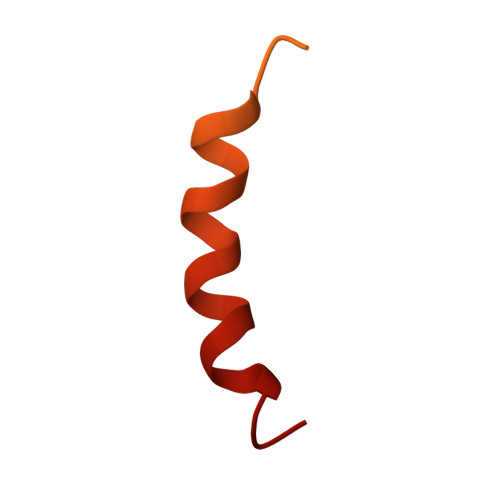NMR Structure of a Complex Containing the TFIIF Subunit RAP74 and the RNA polymerase II carboxyl-terminal domain phosphatase FCP1
Nguyen, B.D., Abbott, K.L., Potempa, K., Kobor, M.S., Archambault, J., Greenblatt, J., Legault, P., Omichinski, J.G.(2003) Proc Natl Acad Sci U S A 100: 5688-5693
- PubMed: 12732728
- DOI: https://doi.org/10.1073/pnas.1031524100
- Primary Citation of Related Structures:
1ONV - PubMed Abstract:
FCP1 [transcription factor IIF (TFIIF)-associated carboxyl-terminal domain (CTD) phosphatase] is the only identified phosphatase specific for the phosphorylated CTD of RNA polymerase II (RNAP II). The phosphatase activity of FCP1 is enhanced in the presence of the large subunit of TFIIF (RAP74 in humans). It has been demonstrated that the CTD of RAP74 (cterRAP74; residues 436-517) directly interacts with the highly acidic CTD of FCP1 (cterFCP; residues 879-961 in human). In this manuscript, we have determined a high-resolution solution structure of a cterRAP74cterFCP complex by NMR spectroscopy. Interestingly, the cterFCP protein is completely disordered in the unbound state, but forms an alpha-helix (H1'; E945-M961) in the complex. The cterRAP74cterFCP binding interface relies extensively on van der Waals contacts between hydrophobic residues from the H2 and H3 helices of cterRAP74 and hydrophobic residues from the H1' helix of cterFCP. The binding interface also contains two critical electrostatic interactions involving aspartic acid residues from H1' of cterFCP and lysine residues from both H2 and H3 of cterRAP74. There are also three additional polar interactions involving highly conserved acidic residues from the H1' helix. The cterRAP74cterFCP complex is the first high-resolution structure between an acidic residue-rich domain from a holoenzyme-associated regulatory protein and a general transcription factor. The structure defines a clear role for both hydrophobic and acidic residues in proteinprotein complexes involving acidic residue-rich domains in transcription regulatory proteins.
Organizational Affiliation:
Department of Biochemistry, University of Georgia, Athens, GA 30602, USA.















